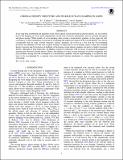Coronal density structure and its role in wave damping in loops
Abstract
It has long been established that gradients in the Alfvén speed, and in particular the plasma density, are an essential part of the damping of waves in the magnetically closed solar corona by mechanisms such as resonant absorption and phase mixing. While models of wave damping often assume a fixed density gradient, in this paper the self-consistency of such calculations is assessed by examining the temporal evolution of the coronal density. It is shown conceptually that for some coronal structures, density gradients can evolve in a way that the wave-damping processes are inhibited. For the case of phase mixing we argue that (a) wave heating cannot sustain the assumed density structure and (b) inclusion of feedback of the heating on the density gradient can lead to a highly structured density, although on long timescales. In addition, transport coefficients well in excess of classical are required to maintain the observed coronal density. Hence, the heating of closed coronal structures by global oscillations may face problems arising from the assumption of a fixed density gradient, and the rapid damping of oscillations may have to be accompanied by a separate (non-wave-based) heating mechanism to sustain the required density structuring.
Citation
Cargill , P , De Moortel , I & Kiddie , G 2016 , ' Coronal density structure and its role in wave damping in loops ' , Astrophysical Journal , vol. 823 , no. 1 , 31 , pp. 1-10 . https://doi.org/10.3847/0004-637X/823/1/31
Publication
Astrophysical Journal
Status
Peer reviewed
ISSN
0004-637XType
Journal article
Description
This project has received funding from the Science and Technology Facilities Council (UK) and the European Research Council (ERC) under the European Unionʼs Horizon 2020 research and innovation program (grant agreement No 647214). The research leading to these results has also received funding from the European Commission Seventh Framework Programme (FP7/2007-2013) under the grant agreement SOLSPANET (project No. 269299, www.solspanet.eu/about).Collections
Items in the St Andrews Research Repository are protected by copyright, with all rights reserved, unless otherwise indicated.

